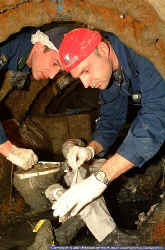Special Projects
H.L. Hunley
The H.L. Hunley was the first submarine to ever sink a ship. Watersorb.com and Polymers, Inc. were selected to work with the team raising, preserving and restoring the Hunley. The preservation team determined that covering and shipping the fragile artifacts in polymer would insure their survival.
History
H.L. Hunley was a Confederate submersible that demonstrated the advantage and danger of undersea warfare. Although not this nation's first submarine, Hunley was the first submarine to engage and sink awarship.
 Privately built in 1863 by Park and Lyons of Mobile, Alabama, Hunley was fashioned from a cylindrical iron steam boiler, which was deepened and also lengthened through the addition of tapered ends. Hunley was designed to be hand powered by a crew of nine: eight to turn the hand-cranked propeller and one to steer and direct the boat. As a true submarine, each end was equipped with ballast tanks that could be flooded by valves or pumped dry by hand pumps. Extra ballast was added through the use of iron weights bolted to the underside of the hull. In the event the submarine needed additional buoyancy to rise in an emergency, the iron weight could be removed by unscrewing the heads of the bolts from inside the vessel.
Privately built in 1863 by Park and Lyons of Mobile, Alabama, Hunley was fashioned from a cylindrical iron steam boiler, which was deepened and also lengthened through the addition of tapered ends. Hunley was designed to be hand powered by a crew of nine: eight to turn the hand-cranked propeller and one to steer and direct the boat. As a true submarine, each end was equipped with ballast tanks that could be flooded by valves or pumped dry by hand pumps. Extra ballast was added through the use of iron weights bolted to the underside of the hull. In the event the submarine needed additional buoyancy to rise in an emergency, the iron weight could be removed by unscrewing the heads of the bolts from inside the vessel.
 On 16 February 1864, the Confederate submarine made a daring late night attack on USS Housatonic, and 1800-ton sloop-of-war with 23 guns, in Charleston Harbor off the coast of South Carolina. H.L. Hunley rammed Housatonic with spar torpedo packed with explosive powder and attached to a long pole on its bow. The spar torpedo embedded in the sloop's wooden side was detonated by a rope as Hunley backed away. The resulting explosion that sent Housatonic with five crew members to the bottom of Charleston Harbor also sank Hunley with its crew of nine. H.L. Hunley earned a place in the history of undersea warfare as the first submarine to sink a ship in wartime.
On 16 February 1864, the Confederate submarine made a daring late night attack on USS Housatonic, and 1800-ton sloop-of-war with 23 guns, in Charleston Harbor off the coast of South Carolina. H.L. Hunley rammed Housatonic with spar torpedo packed with explosive powder and attached to a long pole on its bow. The spar torpedo embedded in the sloop's wooden side was detonated by a rope as Hunley backed away. The resulting explosion that sent Housatonic with five crew members to the bottom of Charleston Harbor also sank Hunley with its crew of nine. H.L. Hunley earned a place in the history of undersea warfare as the first submarine to sink a ship in wartime.
The Wreck
The search for Hunley ended 131 years later when best-selling author Clive Cussler and his team from the National Underwater and Marine Agency (NUMA) discovered the submarine after a 14-year search. At the time of discovery, Cussler and NUMA were conducting this research in partnership with the South Carolina Institute of Anthropology and Archaeology (SCIAA). The team realized that they had found Hunley after exposing the forward hatch and the ventilator box (the air box for the attachment of a snorkel). The submarine rested on its starboard side at about a 45-degree angle and is covered in a 1/4 to 3/4-inch encrustation of ferrous oxide bonded with sand and shell particles. Archaeologists exposed a little more on the port side and found the bow dive plane on that side. More probing revealed an approximate length of 34 feet with most, if not all, of the vessel preserved under the sediment.
In August 2000 archaeological investigation and excavation culminated with the resurrection of Hunley from its watery grave. A large team of professionals from the Naval Historical Center's Underwater Archaeology Branch, National Park Service, the South Carolina Institute of Archaeology and Anthropology and various other individuals investigated the vessel, measuring and documenting it prior to preparing it for removal. Once the on site investigation was complete harnesses were slipped underneath the sub one by one and attached to a truss designed by Oceaneering, Inc. Then after the last harness had been secured, the crane from Clarissa B began hoisting the submarine from the mire of the harbor. On August 8 at 8:37 AM the sub broke the surface for the first time in over 136 years where it was greeted by a cheering crowd lining the shore and in hundreds of nearby watercraft. Once safely on its transporting barge, Hunley finally completed its last voyage back to Charleston. The removal operation reached its successful conclusion when the submarine was secured inside the Warren Lasch Conservation Center in a specially designed tank of freshwater to await conservation.
All who viewed the vessel said Hunley incorporated an unexpectedly graceful and beautiful design. It is certainly a marvel both for its time period and for modern day researchers. No doubt this small submarine will be the key to unlock many mysteries of a bygone era.

